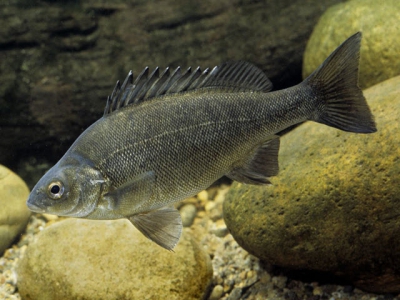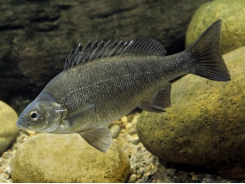Diseases of the Australian Freshwater Fish Silver Perch (Bidyanus bidyanus) - Part 9

NUTRITIONAL DISORDERS
Poor feeding practices such as overfeeding, underfeeding, feeding incorrect pellet sizes, the use of unsuitable or unpalatable diets and the feeding of contaminated or poor quality feed can have detrimental effects on fish health. Overfeeding fish can lead to water quality problems in particular low DO and high ammonia, and underfeeding or feeding the wrong sized pellets results in inadequate nutrition, poor performance and increased susceptibility to disease. Most diets are formulated for specific species or species groups, e.g. for optimal performance and health, carnivorous fish require higher levels of protein and energy than omnivorous fish. Adequate levels of proteins, and vitamins and minerals are essential for growth.
The use of inappropriate diets can lead to health problems such as poor performance, excessive fat deposition, necrosis of the liver, parasitic diseases (see Ergasilids) or skeletal deformities (Figs. 107, 108 and 109). Feeds high in fat can oxidise and become rancid affecting mineral and vitamin availability and shelflife. Vitamin C and E deficiency and rancid food ingestion can cause immune depression, deformity, hepatic degeneration and ulceration. There have been reports of high mortalities of native fish in recirculating tank systems following the feeding of food contaminated with moulds and suspected aflatoxin. Severe disease has also been observed in association with feeding very old feed (>12 months since manufacture). Fish in ponds are at less risk of nutritional problems, particularly those farmed at lower stocking densities where natural feed may be available.


Signs
Poor growth, emaciation, starvation
Skeletal abnormalities
Acute mortality following the feeding of contaminated feed
Fin erosion
Fatty liver
Poor response to normal handling procedures
Concomitant disease such as bacterial or fungal infections
Diagnosis
Problems arising in species having well defined nutritional requirements are usually the result of poor feeding practices, or inappropriate storage or formulation of feeds. Suspected deficiencies in the diet require analyses by qualified nutritionists or biochemists. Collection of an accurate history of events, including feed manufacture dates, delivery and storage, and records of feeding, can provide information to help diagnose a nutritional problem.
Prevention
Use recommended feeding regimes and silver perch diets; handle and store feed in rooms having low humidity and temperatures <14°C; only order enough feed for approximately 3–4 months feeding. Ensure feed is recently manufactured.
AGGRESSION
Silver perch in small cages and tanks can display aggressive behaviour. Research has shown the problem more prevalent in smaller cages and tanks having moderate stocking densities (25–50 fish/ m3 ) rather than lower and higher densities. The cause of the behaviour is unknown, but is probably linked to the establishment of hierarchies involving aggressive and subordinate fish. Aggressive silver perch nip fins (mainly caudal) and flanks of submissive fish causing skin damage and necrosis, and fraying of the soft fin rays (Fig. 110). Submissive fish position themselves near the water surface on the sides of the tanks and cages; these fish do not feed, grow poorly and eventually become moribund and die. Secondary bacterial and fungal infections are common. Silver perch held in purging systems for shorter periods (<14 days) and at higher stocking densities (>25 kg/ m3 ) behave normally.
Signs
Moribund fish and/or mortality in tanks and cages
Individual fish stationary near surface and corners of cages/tanks
Skin necrosis, scale loss, blotchy appearance
Sporadic commotion in tanks/cages
Diagnosis
Observation of aggressive behaviour between individuals particularly in fish held in small cages or tanks (e.g. 1m3 ) at moderate, rather than light or heavy stocking densities; observation of clinical signs in the absence of other supportive disease diagnosis.
Treatment
Removal of affected fish to other tanks/ cages; culling of aggressive individual fish; lowering or increasing stocking densities. Underfeeding of fish in tanks/ cages can exacerbate the problem. Use salt and/or antimicrobial on fish having scale loss, fungal or bacterial infections.
Prevention
Avoid containment of fish in small tanks/cages over long periods (months); stock fish at low (<15 fish/m3 ) or high densities (>100 fish/m3 , grow-out); hold broodfish in cages (up to 8 fish/m3 ). Feed fish to satiation using semifloating feeds and use feeding rings in cages.
DISEASE PROBLEMS IN PURGING SYSTERM
Diseases are common in purging and tank systems in the silver perch industry. Purging (called ‘conditioning’ in the Silver Perch Quality Assurance Program), or the removal of offflavours from fish, ensures a uniform, high quality product for the market. Purging requires harvested fish to be held in tanks for up to 7 days in clean, wellaerated water. Three management options are generally used: (i) a static system using periodic, ‘batch,’ water exchange; (ii) a recirculating system using tanks, filtration and UV units; (iii) a combination of the two. Generally, disease problems are more prevalent in recirculating systems under the following conditions: (i) where there is minimal or zero water exchange, particularly in the first 24 hours after harvesting; (ii) when poor husbandry practices have been used during the harvest; (iii) the use of poorly designed purging systems; (iv) where the system has not been ‘conditioned’ to assimilate sudden increases in ammonia and nitrite caused by the stocking of large numbers of harvested fish. Bacterial and fungal diseases are the most common. Heavy infestations of gill flukes are also common in purging systems and are difficult to eradicate due to the resistance of the egg stage to salt and other chemicals. It is important to recognise that when fingerlings are held in purging tanks, they can be readily infested. Treatment of fish to eliminate all parasites before stocking ponds and tanks is strongly recommended.
Signs
Clinical signs include chronic mortality (5–10 fish/day, starting 2–3 days postharvest) frayed fins, blotchy skin, haemorrhaging, white patches on the head and caudal peduncle, dark skin, swimming into currents and lethargy. Prevention of disease in purging systems
Do not harvest diseased fish.
Do not harvest fish from ponds with poor water quality.
Do not feed fish for 2–3 days prior to harvest (prevents fouling of water and high ammonia postharvest). Implement good harvest procedures (use oxygen, low stocking densities and anaesthetics in transport; measure water quality in pond, transport and purging system). Stock fish at rates < 30 kg/m 3 in clean, wellaerated water postharvest. Exchange water in tanks constantly during harvest, then ~ 80% of water (in static systems) the day after harvest, and then periodically (>30%; every 2nd to 3rd day) to remove organic matter, dilute bacterial loads and flush ammonia.
Hold fish in continuous bath (>48 h) of 2–5 g/L salt to prevent fungal infections, reduce stress and prevent nitrite poisoning; resalt following water exchange to ensure a level of 2–5 g/L is maintained.
Measure water quality regularly (daily); DO, pH, salinity and ammonia. Do not feed fish in the purging system.
Regularly clean/scour purging system including pipes, tanks and biofilters. Leave water circulating permanently through biofiltration units (desiccation of the system will kill nitrification bacteria).
Periodically treat purging system with trichlorfon to lower fluke levels.
Holding some fish permanently in recirculating systems will help ‘condition’ or keep a load on the biofiltration units; however, the filter’s nitrification potential (the process of changing ammonia to nitrite then nitrate), is severely compromised following the introduction of large biomasses of fish (and subsequently ammonia) and any other sudden alterations to water quality (e.g. adding salt). Nitrification is further compromised when the biofilter’s specific surface area (SSA) is undersized and is unable to assimilate the ammonia load, and/or the biofilter has been contaminated with organic matter (mucus, scales, grass, and suspended solids) due to inadequate prebiofilter filtration or water exchange.
Aquatic plants and fish health
The presence of large, aquatic plants (macrophytes) in aquaculture ponds is undesirable. Plant species including milfoil (Myriophyllum sp.), cumbungi (Typha sp.) (Fig.111), ribbonweed (Vallisneria sp.) and water thyme (Hydrilla spp.) (Figs.112 and 113) have been problematic in some silver perch ponds. While some plant species are restricted to shallow areas of ponds, submerged species such as ribbonweed and water thyme are capable of colonising the entire pond including deeper sections. Some species of duckweed (Lemnaceae) are capable of rapid propagation, budding from adult plants and covering entire surfaces of ponds in a few days. Macrophytes can have a significant effect on the maintenance of fish health and the treatment and control of disease in the following ways.

Interfere with pond management and feeding.
Impact on water quality (clear water, compete with phytoplankton for nutrients, cause abnormally high pH levels).
Crowd the fish and enhance disease transfer, particularly ectoparasites.
Restrict water flow and therapeutic chemical distribution and concentrations.
Interfere with chemical concentrations due to high organic load.
Provide havens for fish and parasites which may remain untreated. Contribute to oxygen depletion and high TAN levels when they decompose. Contribute to water loss through evapotranspiration. Hinder or prevent sampling and harvesting.
Management
Dry and desilt ponds every 1–2 years.
Harvest problem weeds as soon as they appear especially prior to their seeding. Increase phytoplankton turbidity through correct feeding regimes and/or application of fertiliser. Use a herbicide (contact Extension Service for advice).
Prevention
Avoid contamination from waters introduced from other locations (e.g. fish transportation water); dissuade aquatic birds; exclude farm stock such as cattle from ponds; use bore or well waters and prevent runoff into surface supplies and ponds; quarantine all fish coming onto the property.
Related news
Tools

Phối trộn thức ăn chăn nuôi

Pha dung dịch thủy canh

Định mức cho tôm ăn

Phối trộn phân bón NPK

Xác định tỷ lệ tôm sống

Chuyển đổi đơn vị phân bón

Xác định công suất sục khí

Chuyển đổi đơn vị tôm

Tính diện tích nhà kính

Tính thể tích ao



 Vaccines provide tilapia producers with a platform for…
Vaccines provide tilapia producers with a platform for…  Diseases of the Australian Freshwater Fish Silver Perch…
Diseases of the Australian Freshwater Fish Silver Perch…